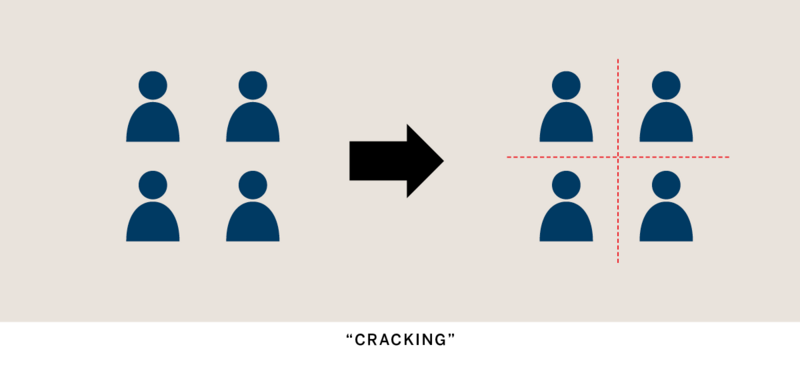Redistricting Pt. 1 - What is it and How Does it Impact Local Education?
/In the wake of federal, state, and local redistricting efforts following the 2020 United States Census, political discourse around redrawing district lines tends to focus on the implications for hot-button issues like abortion rights and COVID-19 public health restrictions. A less discussed, but no less important, implication of redistricting is educational inequity. Redistricting that results in politically and racially unbalanced boundaries reinforces this country’s legacy of educational segregation and exacerbates other systemic societal harms.
Partisan and Racial Gerrymandering
Every ten years, the United States Census Bureau counts the country’s population by state. These counts are then used to determine the number of Congressional representatives allocated to each state. Given that there is a fixed number of representatives – 435 total seats in the House – as populations grow and shift, so must congressional districts. Redistricting is the process of creating representational district maps for state and local communities and is completed based on data from the census count. Redistricting not only impacts how communities are represented, it affects how finite funds for public services are disbursed.
There is no universal process for creating district maps. States utilize a variety of approaches in redistricting. Some states delegate the task to an independent voter commission while others leave it up to state legislators. Whereas many redistricting commissions are composed of nonpartisan citizens and advisors, when redistricting is assigned to state legislators, these legislators are incentivized to draw their own boundaries and essentially pick their own voters. Gerrymandering is the practice by parties in power to manipulate electoral boundaries to favor their own party, drawing districts to dilute the influence of voters who oppose them and increase the influence of their own voters. There are two types of gerrymandering: political and racial.
Political gerrymandering is the drawing of electoral lines to favor one political party over another. In 2019, the Supreme Court ruled that federal courts cannot decide challenges to political gerrymandering because it is inherently political rather than legal in nature. See Rucho v. Common Cause. This type of gerrymandering is considered to be non-justiciable in federal courts, because it has been deemed inappropriate for judicial deliberation or resolution.
Racial gerrymandering is the drawing of electoral lines to dilute the power of minority voters. In practice, this often looks like cramming minority voters into one district as opposed to a fair and competitive spread (“packing”), or splitting up neighborhoods by grouping small amounts of minority voters with enough white voters to dilute their influence (“cracking”). (See “What is racial gerrymandering?” on now.org.)
Gerrymandering of Educational Boundaries at the Local Level
At the local level, the redrawing of school districts tends to concentrate low-income students in underfunded and failing schools, magnifying educational inequities. Research shows, however, that school diversity has positive effects on achievement for all students. However, despite the potential and imperative to diversify schools, urban schools remain highly segregated. In most major urban centers, schools are funded with a baseline grant from the state in addition to a certain amount of funds derived from property taxes. States, and therefore gerrymandered legislative majorities, tend not to provide sufficient funding at a baseline to maintain educational standards without significant property tax revenue. Tight budgets often result in school closures, sending students from closed schools to other schools that are either far away from home, less diverse, or lower performing. In a Harvard study examining an unnamed major metropolitan school district, researchers observed that while merging several segregated schools would have solved capacity issues and increased racial and socioeconomic diversity, policymakers chose to redraw school zones. This rezoning moved many minority and low-income students from diverse, academically competitive feeder schools into lower-performing and highly segregated schools. Disinvestment in inner city schools then multiplies, as white middle class parents hesitate to send their children to schools they perceive as underfunded, depriving districts of tax revenue and parents with greater levels of political and social capital. Even pro-public school middle class white parents are discouraged from investing time and resources into neighborhood schools, given the appearance that diverse schools will always get the short end of the stick when dealing with districts and the state. Given that school districts fall under the purview of the state, and are often drawn along similar lines to political districts, gerrymandering directly impacts the assignment of students to schools as well as the allocation of funds to these schools.
Missouri state Rep. Doug Richey (R) points out elements of a proposed congressional redistricting map to fellow lawmakers during House debate on May 9 in Jefferson City, Mo. (David A. Lieb/AP) - From Washington Post Article titled, “I was gerrymandered out of my Missouri district. Voters deserve real competition.”
Far from a simple political issue confined to statehouses, gerrymandering directly and indirectly impacts the quality of education children receive, acting through the mechanisms of funding, censorship, and school zones. Given that underprivileged communities, with less political capital and lacking the options to move or put their children in private school, are especially vulnerable to educational shortcomings, gerrymandering takes on tremendous importance in the fight for fair schools. While educational equity is a complex and multifaceted goal, ensuring fairly drawn districts is a huge step towards just representation at the state level.
Learn more about the impacts of gerrymandering on the Brennan Center for Justice’s website.






